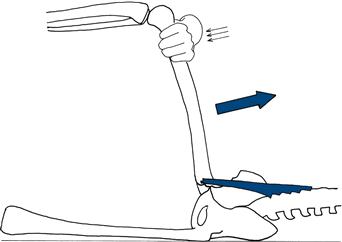Motor System
Legs
BACKGROUND
Upper motor neurone or pyramidal weakness predominantly affects hip flexion, knee flexion and foot dorsiflexion.
Simplified root distribution in the legs is shown in Table 18.1
Table 18.1
| Nerve roots | Movement | Reflex |
| L1, L2 | Hip flexion | No reflex |
| L3, L4 | Knee extension | Knee reflex |
| L5 | Dorsiflexion of foot, inversion and eversion of ankle, extension of great toe | No reflex |
| S1 | Hip extension, knee flexion, plantarflexion | Ankle reflex |
Femoral nerve supplies knee extension.
Sciatic nerve supplies knee flexion. Its branches are:
WHAT TO DO
Look at the legs for wasting and fasciculation.
Note especially the quadriceps, the anterior compartment of the shin, the extensor digitorum and brevis, and the peroneal muscles.
Look for the position and for contractures, especially at the ankle; look at the shape of the foot, a high arch or pes cavus.
Pes cavus is demonstrated by holding a hard, flat surface against the sole of the foot; a gap can be seen between the foot and the surface.
Power testing screening
Compare the left with the right.
Hip flexion
Ask the patient to lift his knee towards his chest. When the knee is at 90 degrees, ask him to pull it up as hard as he can; put your hand against his knee and try to overcome this (Fig. 18.1).

Figure 18.1 Testing hip flexion
Hip extension
The patient is lying flat with his legs straight. Put your hand under his heel and ask him to push down to press your hand (Fig. 18.2).
• Nerve: inferior gluteal nerve







